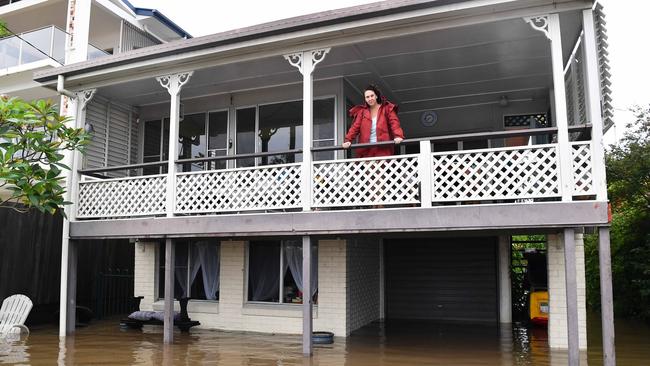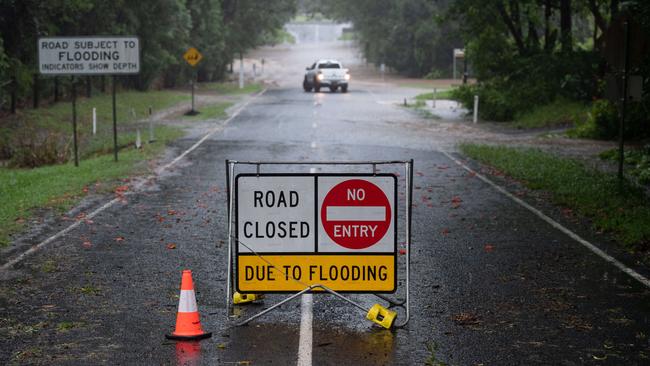Sunshine Coast flooding: Groups call for greater protection of flood plains
Groups are calling for flood plain development to be banned after the Sunshine Coast was inundated with water leaving homes destroyed, businesses battered and roads torn up.

Sunshine Coast
Don't miss out on the headlines from Sunshine Coast. Followed categories will be added to My News.
Groups are demanding developments on flood plains and flood prone land be abandoned after the Sunshine Coast was inundated in a rain bomb event.
Widespread totals of more than 1000mm fell throughout the six days with the drenching starting late on Tuesday, February 22 and lasting into Sunday, February 27.
The downpour cut hinterland areas off and closed major roads such as the Sunshine Motorway at Coolum Beach and left swathes of rural land drenched.
Sunshine Coast Mayor Mark Jamieson said considering the region was “a very large flood plain” the stormwater system worked well.
But the event has left key community groups concerned about future development of flood prone areas and flood plains.

Organisation Sunshine Coast Association of Residents president Melva Hobson held particular concerns about development north of the Maroochy River.
“If people can’t see this is now a serious issue I don’t know where you go from here,” Ms Hobson said.
“Our flood plains need to be maintained, not reduced in area or capacity.”
Mr Jamieson said he was interested in understanding the flood’s impact on the hospital at Kawana and the CBD at Maroochydore – both in low lying areas.
“(The hospital has) been criticised by some as being in the wrong place and it worked fine,” he said.
“The CBD in Maroochydore is another area that people suggested is low lying, well again with the best part of a metre of rain running over the Coast I think all those areas have performed very well.”
“I think the work council has done in approving developments via the planning scheme or through Economic Developments Queensland, those areas have been safe.
“To the best of my knowledge, there was very little inundation of properties right across the Sunshine Coast.”
Development Watch president Lyn Saxton said the recent events should serve as a warning.
She echoed concerns about protecting flood plain north of the Maroochy River and hoped developers including World Surf League and Consolidated Properties’ would reconsider plans for a surf park and development at Coolum West.
She also raised concerns about new proposals for housing at Bli Bli with the Parklakes Central project.
“When I saw the photos of Coolum West I just thought ‘thank goodness we have that flood plain there to take all of that water’ otherwise heavens knows where it would have gone,” Ms Saxton said.
The recent event also left Bradman Ave on the Maroochy River flooded for days.
Ms Saxton noted New South Wales passed legislation last year to provide councils with greater protections for rejecting developments on flood plains.

She said the state government should look into similar rules to help local councils and residents who live near flood plains.
“We need to let these flood plains do what they are meant to be doing, to provide that natural flood storage and protect our communities,” Ms Saxton said.
“I think we did get off lightly this time but with climate change these events are going to be more severe.”
Covey and Associates director Kevin Covey – who has been involved in Bli Bli developments Parklakes 1 and 2 and recent proposals for Parklakes Central – said development was possible on flood plains provided there was no loss of flood storage within the catchment.
“Rigorous assessments and detailed flood modelling are undertaken to ensure flood plain storage is preserved,” Mr Covey said.
Mr Covey said to his knowledge Parklakes 1 and 2 did not experience flood damage to any properties.
He said the proposed site for the 200-home Parklakes Central was at the “upper reaches” of the flood plain and it met council and state requirements.
“Similar to other developments on the Sunshine Coast, including Parklakes 2 and Pelican Waters, a lake will be constructed in the development which will have significant storage for rainfall above the normal water level to cater to major rainfall events, such as the one just experienced,” Mr Covey said.
“All developed land will be a minimum of 500mm above the one per cent AEP (Q100) level, taking climate change into account.
“The proposed development will provide the required storage volumes suitable to cater for these major events, including rainfall events similar to that which occurred.”
A Department of State Development spokesman said councils had developed comprehensive approaches to planning for flooding in planning schemes.
‘They already have the power to refuse development applications where flood risk cannot be appropriately managed,” they said.
“Local governments also have the power to condition development applications to require flood mitigation measures.”




